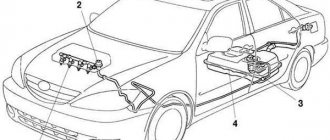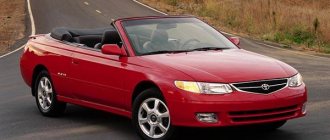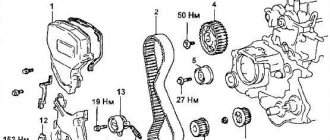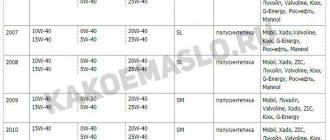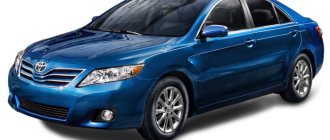5474 Apr 20
Many motorists ask the question: how long does it take for the Camry 3.5 to accelerate to a speed of one hundred km/h? It is not so easy to check this yourself; the result can be influenced by the technical condition of the car, the condition of the road, its evenness, weather conditions, the tires installed on the car, the skill of the driver, and the lack of equipment capable of accurately recording time. In order to answer the question of whether the manufacturer’s data is true, it is necessary to conduct tests under ideal conditions. We collected the necessary data and obtained intriguing results.
Factors affecting acceleration speed
The power of the power unit determines the potential capabilities of the vehicle in terms of speed of reaching 100 km/h. However, in practice it is necessary to take into account:
- vehicle weight and workload;
- speed of gear shifting and transmission losses;
- aerodynamic parameters of the body;
- wind strength and direction;
- air temperature and humidity, atmospheric pressure;
- road surface condition;
- the presence of slopes and inclines on the route;
- tire features (tread pattern and width, pressure).
Instead of complex theoretical calculations, it is more convenient to use test runs with instrumental measurement of acceleration dynamics.
Whose cars are the fastest?
The activities of international and national certification institutes focus on safety issues. Special standards ensure the safety of drivers, passengers and pedestrians. There are restrictions on emissions that pollute the environment. However, there are no common standards for measuring dynamics.
Each manufacturer has the right to use its own testing rules. FIAT and VW engineers place 30 and 200 kg of cargo in the cabin, respectively. The difference of 170 kg has a significant impact on acceleration to 100 km/h. If car models are equipped with low-power engines, the test results, all other things being equal, will differ by 0.5-1.5 seconds.
If vehicles with a manual transmission are tested, the result depends on the skill of the driver. For dynamic acceleration:
- start with slight wheel slip;
- quickly change gears (in 0.15-1.2 seconds);
- maintain high crankshaft speeds.
It is easier to solve a similar problem with an automatic machine. You just need to set the box switch to sports mode so that the electronics do not limit the fuel supply to improve economic performance.
Control runs are performed with the air conditioner and other energy consumers turned off. Acceleration is accelerated:
- narrow tires;
- lightweight disks;
- overlays that improve aerodynamics;
- oils with reduced viscosity.
Special methods are used by the editorial offices of automobile magazines and certification laboratories.
To eliminate errors caused by differences in technologies, the review examines the official data of the manufacturer.
Capabilities of a more powerful brother
There is a configuration where a 2.4 liter engine is installed. This is an overhead valve four-cylinder engine with a power of 167 hp. With. Thanks to two camshafts, the cylinders operate as efficiently as possible. The 2.4 liter engine can develop up to 6000 rpm, pulls well uphill, and performs well on the highway.
Camry 2.4 accelerates to 100 according to factory data in 9.1 s. In practice, the figure does not differ much; one can hardly notice a difference of tenths of a second between an automatic transmission and a manual one. When driving in a mixed cycle, a car with a 2.4 liter unit needs 6–7 liters of fuel, and if the model is equipped with an automatic transmission, the consumption increases by 1–2 liters.
The 2.4 liter power unit is technically more modern than the one discussed earlier, therefore it is economical if driving is not aggressive.
Japanese Toyota Camry models
Cars for the domestic market are distinguished not only by right-hand drive, but also by advanced equipment. Designers offer engine modifications with increased power. The latest technical solutions are added to the package, which are used in production cars for other countries after several years of practical testing.
| Model (generation) | Acceleration time, s | Maximum speed, km/h | Power, hp | Transmission | Fuel |
| 1.8LT (V10) | 11,2 | 168 | 100 | Manual transmission5 | petrol |
| 2.0 Lumiere (V30) | 9,4 | 200 | 140 | Manual transmission5 | gasoline AI-95 |
| 2.4G (XV30) | 9,4 | 210 | 159 | Manual transmission5 | gasoline AI-95 |
| 2.4 G limited edition (XV50) | 9,3 | 205 | 167 | Automatic transmission5 | gasoline AI-92 (95) |
| 2.5G package (XV60) | 9 | 210 | 160 (105 kW - electric motor) | variable speed drive | gasoline AI-92 (95) |
| 2.5X (XV70) | 9 | 210 | 181 (88 kW) | variable speed drive | gasoline AI-92 (95) |
Old car generations
The founder of the series is a sedan created on the basis of the Toyota Celica sports coupe. The designers made it front-wheel drive, used a transverse engine arrangement, and increased the wheelbase. With a curb weight of 1265 kg, the most powerful rare version (160 hp) of the first generation V10 accelerates to hundreds in 8.9 seconds. A diesel car (85 hp) is designed for leisurely driving with economical fuel consumption. In the absence of a strong headwind, it will take at least 15.5 seconds to accelerate to the same speed.
In V20 models, engines with injection were installed, which, together with an increase in volume to 1998 cm3. helped increase the power of production models to 140 hp. Accordingly, the specific indicators were improved - 8.5 hp/kg versus 9.9 hp/kg in the previous generation cars.
The next series (V30) received high marks from consumers in the Japanese market as a well-balanced family car. They produced modifications with all-wheel drive and a four-speed automatic transmission, gasoline and diesel engines with power from 91 to 140 hp.
From 1996 to 2004, 3 generations of Camry were produced. After the latest restyling, the XV30 model acquired an appearance that, even in 2020, does not look anachronistic.
Compliance with the business class level is confirmed by electric seat drives, a built-in navigation system, and other additional options in the basic equipment.
Camry XV40
The seventh generation is well adapted to the conditions of daily use. The following parameters have been increased:
- trunk volume;
- base;
- cabin width.
Xenon headlights, dual-zone climate control and built-in hard drive storage are added as standard. The increase in weight is compensated by a powerful engine, which, in combination with a new five-speed gearbox, provides good acceleration dynamics.
XV50 and restyling
The main innovation in this generation is the appearance of a hybrid power unit. In combination with a variator, this engineering solution reduced fuel consumption and ensured smooth acceleration with minimal losses in the transmission, and reduced noise levels.
Toyota Camry XV70
The ninth generation of Camry was created using modular construction of automotive structures. With this series, the division of design for domestic and foreign markets has been discontinued. However, only in Japan the Camry XV70 is offered with a hybrid powertrain. The improved gasoline engine has more power while maintaining good fuel consumption indicators - 3 liters per 100 km in the combined cycle.
XV40
The 2.4-liter engine and manual gearbox are capable of reaching 100 in 9.6. The same engine with automatic transmission produces a modest result of 10.2, as well as an increase in fuel consumption.
The three and a half liter Camry engine with an automatic transmission before restyling produces a result of 7.4. Of course, for a 3.5 engine, the Camry XV40’s acceleration is rather weak, the reason being the front-wheel drive, which is not capable of delivering as much power and torque.
The same engine after restyling boasts an indicator of 6.8 seconds. The 2.4 engine with a manual transmission accelerates the Camry to 100 in 9.1, and the automatic transmission in 9.3 seconds. Thus, after restyling, the acceleration figures of the XV40 decreased with the same engines and gearboxes. All Camry modifications described above have front-wheel drive, however, in the domestic Japanese market it was possible to purchase the XV40 with all-wheel drive.
Overclocking the Russian assembly
For the production of cars, a specialized plant was built in Russia (St. Petersburg, Shushary). Since 2007, Camry has been assembled according to a full cycle scheme, which includes welding and painting of the body. In 2014, the production of stamped parts and individual functional components made of plastic was mastered. The use of corporate standards ensures high quality of finished products. Many work operations are automated, which eliminates accidental personnel errors.
| Model (generation) | Acceleration time, s | Maximum speed, km/h | Power, hp | Transmission | Fuel |
| 2.0 AT Classic (XV70) | 11 | 210 | 150 | Automatic transmission6 | gasoline AI-92 |
| 2.5 AT S-Edition 90 (XV70) | 9,9 | 210 | 181 | Automatic transmission6 | AI-92 |
| 3.5 AT Lux Safety (XV70) | 7,7 | 220 | 249 | Automatic transmission8 | AI-92 |
| 3.5 AT Lux (XV55) | 7,1 | 210 | 249 | Automatic transmission6 | AI-92 |
| 3.5 AT Luxe (XV40) | 6,8 | 230 | 277 | Automatic transmission6 | AI-98 |
| 2.4AT (XV30) | 10,5 | 200 | 152 | Automatic transmission4 | AI-95 |
| 2.2 AT R1 (XV20) | 11,7 | 195 | 131 | Automatic transmission4 | AI-92 |
| 3.0MT (XV10) | 11,8 | 195 | 188 | Manual transmission5 | AI-95 |
XV70, 9th generation
New products appear on the Russian market with a slight delay after being introduced in Japan, the USA and Europe. Camry XV 70, like previous models, is assembled in Shushary. The car is equipped with gasoline engines (2.0; 2.5; 3.5 l). The most powerful power unit is specially derated to 249 hp to reduce transport tax for owners. This feature allows you to pay in Moscow instead of 40,200 rubles as of 2021. (268*150) almost 2 times less - 18,675 rubles. (249*75).
Model XV50-55
The eighth generation Toyota Camry has been produced since 2011 with 2 upgrades in 2014 and 2021. In the inexpensive version, the cars were equipped with a 2-liter inline “four” with a relatively simple 4-speed automatic transmission. The most powerful engine (249 hp) in the automatic transmission6 configuration provides better acceleration compared to the latest XV70 series with worse efficiency indicators: 7 versus 6.4 l/100 km highway consumption.
XV40 Series
Cars of this series were produced from 2006 to 2011 without technical changes due to the peculiarities of Russian taxation. A powerful V-shaped six in combination with a 6-speed automatic accelerates the Camry to hundreds in 6.8 seconds. However, for these advantageous indicators you will have to pay more during operation. Consumption of expensive high-octane gasoline in the urban cycle is 14.1 liters per 100 km.
Older Camry models
Before assembly in Russia, cars were supplied from foreign factories. From 1991 to 2006, official dealers offered customers 3 generations (XV10, 20 and 30).
American Toyota
For the US market, they traditionally offer well-equipped cars with an automatic transmission and a powerful engine.
| Model (generation) | Acceleration time, s | Maximum speed, km/h | Power, hp | Transmission | Fuel |
| 2.2 AT Deluxe (V10) | 11,8 | 195 | 130 | Automatic transmission4 | gasoline AI-92 |
| 2.4 CVT Hybrid (V40) | 10,5 | 200 | 147 (33 kW - electric motor) | variable speed drive | AI-95 |
| 2.4 CVT Hybrid (V40, facelift) | 10,2 | 200 | 147 (105kW) | variable speed drive | AI-95 |
| Camry 3.5 AT XSE (V70) | 7,1 | 220 | 301 | Automatic transmission8 | AI-95 |
Models 10 to 30
The first deliveries to this market were made in 1996. The 4th generation Toyota Camry was equipped with 2.2 and 3.0 liter engines (125, 130, 185 and 188 hp) in sedan and station wagon bodies. In the following series, more powerful power units appeared, some of which were intended only for the American market (3.3 l; 210 hp, Camry XV30).
Camry XV40
The parameters of V6 units do not differ in technical characteristics from the standard equipment of other cars of this generation. New - a hybrid power unit.
In combination with a CVT, smooth acceleration was complemented by economical fuel consumption - 7.1 liters in the city.
Seventh generation
During the restyling, the power of the electric motor was increased. Dynamics are improved while maintaining low consumption.
XV70
Cars for the American market are equipped with engines with increased power. The 3.5 liter “Six” develops 301 kW, which is a record figure for this series.
Opinion of car owners
Reviews of the Camry note the following advantages:
- high-quality assembly;
- spacious interior;
- durable engines;
- economical fuel consumption.
The most powerful versions with 3.5 liter engines, intended for the American market, have the best acceleration dynamics. According to experts, front-wheel drive does not allow full power potential to be revealed. New hybrids, when accelerating quickly, consume a small amount of fuel in the city and on the highway.
XV70
Camry in the back of the XV70 2.0 6AR-FE, 2.5 2AR-FE and 3.5 V6 2GR-FKS accelerates to the first hundred slower than the XV55 with the same power plants. This is explained by higher environmental requirements and increased vehicle weight.
Camry XV70 for America XSE
A two-liter unit with an automatic transmission in the Camry XV70 body is capable of covering the speed limit from 0 to 100 in 11 seconds. This gasoline engine is designed in a complex way; all structural parts are made of aluminum, which makes it possible to reduce the weight of the power plant. Increasing the volume of the unit by half a liter makes it possible to gain speed in 9.9. The 3.5 engine and eight-speed gearbox are capable of accelerating a more than one and a half ton car to 100 in 7.7 seconds. This car feels confident on the highway and in the city, and is suitable for motorists who prefer an active and dynamic driving style.
Starting with the XV50, only hybrid Camrys are available in Japan, allowing you to see a hundred on the speedometer in an average of 9 seconds.

